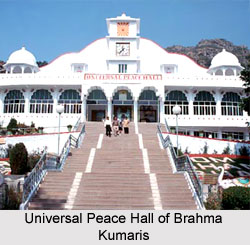 To develop the inner strength, to cultivate the inner values and above all to teach a practical method of meditation The Brahma Kumaris World Spiritual University recognizes the very inherent goodness of all people
To develop the inner strength, to cultivate the inner values and above all to teach a practical method of meditation The Brahma Kumaris World Spiritual University recognizes the very inherent goodness of all people
History of Brahma Kumaris
It`s just not the history but a tale of growth, an account of development and the moving document of moving from nothingness towards a mammoth growth. Brahma Kumaris rich history is an amalgamation of all these and much more.
World Headquarters of Brahma Kumaris
The year 1950 was indeed an important year in the history of Brahma Kumaris. It is in this year the community moved to Mount Abu. Mount Abu, has been credited for its serenity and pristine splendor and certainly for its age-old heritage. Perched high in the Aravalli Mountains, Mount Abu with its divine grandeur had all those ex factors, to be the right place for reflection and contemplation. Perhaps this was the reason why the community moved the headquarters to the Mount Abu. Named as Madhuban (Forest Of Honey) in a rented building there at Mount Abu the community established the University`s World Headquarters.
Expansion of Brahma Kumaris in India
The expansion of Brahma Kumaris in India is again a tale of a ceaseless journey. Dada Lekhraj better known as Brahma Baba felt the sheer necessity to share the knowledge he did receive, with the rest of India. The year was 1952 and with the greater intention of implementing his plans sent a few young women members to Delhi and the then Bombay to establish study centers to teach Raja Yoga meditation. The expansion of Brahma Kumaris in India thus began humbly however today; a single town in India could not be found without a Brahma Kumaris study center.
In The organization did expand rapidly. It was in the year 1971, the permanent centers were established in London and Hong Kong. This further strengthened the roots of the organization whilst leading towards a colossal worldwide expansion in terms of both geographical growths as well as in the growth of overall membership.
World Spiritual University
Today there are thousands of students attending thousands of meditation centres in nearly one hundred countries. Madhuban serves as the nucleus of all the BK centers, This Madhuban complex now includes two campuses, located elsewhere on the mountain, and Shantivan. There is also the Academy for a Better World, also known, as Gyan Sarovar. All these 3 campuses attracts 2.5 millions individual every year. From its modest beginning the organization has come indeed a long way.
Brahma Baba , Founder of Brahma Kumaris
Born in the year 1876 into a humble home as Lekhraj Kripilani, Brahma Baba was the son of a schoolteacher. Strict Hindu tradition was induced in him from his early days. In the year 1836, Baba begun his journey, the journey in understanding the truths of life and founded the Btahma Kumaris.
Spiritual Leaders of Brahma Kumaris
A number of spiritual leaders further carried away the unfinished task of Brahma Baba. Dadi Janaki, Dadi Gulzar are some of the names.
Brahma Kumaris Administration
The World headquarter is ideally seated at the Mout Abu, Rajasthan. It comprises the Administrative Head, Additional Administrative Head, Joint Administrative Head, a Governing Board and a Management Committee
Students of Brahma Kumaris
Brahma Kumaris offers education in moral and spiritual value. Individuals aged above 18, whoever support the guiding, teachings and philosophy of the BKWSU can attend the daily classes twice a week on a regular basis. There is an option of free enrollment also. The students from all strata of the society here at the BK centre thus mirror a variety of backgrounds, echelon of education, profession and age.
Current data show that the University has 825,000 students and over 8,500 centres in 100 countries and territories.
.



















